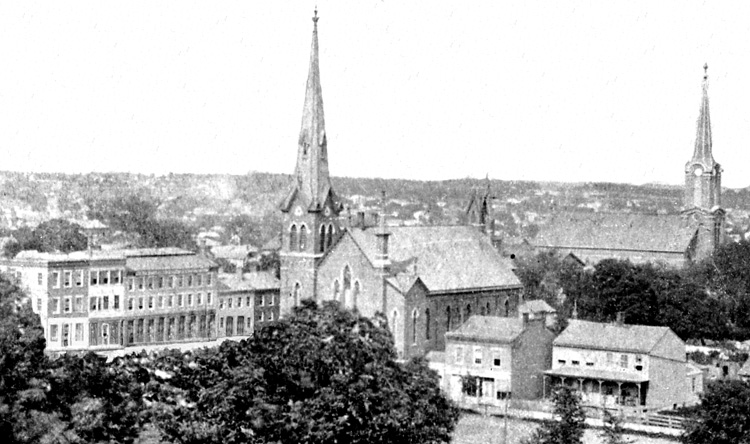
This
image from about 1880 centers on the 1868 Congregational Church, with St.
Mary’s Roman Catholic Church
at right. St. Mary’s steeple was built in 1872, and a building at left
was demolished in 1892, thus helping date the photo.
Enhanced image from Congregational archives courtesy of John Johnson.

|
By
Bob Hibbs
Presbyterians
first stood in the way, then provided the impetus to formation of “The
Congregational Church of Iowa City,” which now adds a “United Church of
Christ” denominational tag below its original name.
During
the early 19th century, eastern Congregationalists believed their church
couldn’t survive outside New England, and that Presbyterian churches were
suited to new communities. “Congregational pastors advised their people
moving west to become Presbyterians,” writes Joseph Heffner in his 1916
local Congregational history.
Only
First Presbyterian Church survives now, but three Presbyterian churches were
born in 1840s Iowa City, forestalling early appearance of a Congregational
group, except for the Welsh Church south of Iowa City in 1846.
But,
local Congregationalists are survivors and a bit like the proverbial tortoise
– slowly and steadily, their towering 1869 downtown house of worship has
become among the oldest surviving local church edifices still in regular
Sunday use. It’s well maintained and appointed.
It
was erected for $26,606 on two lots purchased for a little more than $1,000
each from the historic Berryhill and Reno families. Architect Gurden Randall
earned $650. Administrative space was added in 1924 and classrooms during
1958.
The
“Old Brick” church a block north was completed in 1865 by the
Presbyterians, but it no longer houses regular worship. The African Methodist
Episcopal congregation began meeting in 1868, but exact date of its first
building remains unclear.
Among
vintage local churches, St. Mary’s Roman Catholic also came in 1869 without
its steeple, Trinity Episcopal in 1871 and St. Patrick’s Catholic in 1879.
As
with other denominations, the Congregationalists predate their edifice. They
first organized in 1856, but abandoned that “First” entity and joined a
larger group of “New School” Presbyterians in forming today’s surviving
congregation in 1866. There were 51 charter members, compared to more than 300
actives today.
The
Presbyterians left their 1845 stone church along the south face of Burlington
Street mid-block between Clinton and Capitol streets as long declining
fortunes forced change. This era also witnessed the Iowa capital moved to Des
Moines in 1857, the same year a financial panic hit as devastatingly as the
1930s Great Depression.
Among
items stone church members had liquidated was their bell, sold in 1855 to a
nascent University of Iowa for its first home, the Mechanics Academy on Linn
Street. This bell has been confused with others hung in Old Capitol, although
it never rang there. It’s now stored in the basement of the UI athletics
museum.
A
devastating early blow to local Congregationalists came with lost support of
the John Teesdale family with its move to Des Moines as state government was
relocated. Teesdale had edited the respected Iowa City Republican newspaper,
and there founded what now is the Des Moines Register.
Today’s
dramatically different Congregational Church neighborhood is evidenced by an
1880-era image.
A
three-story building at the left edge housed the Iowa City Academy beginning
in 1878. Founded in 1868 by William McClain in Market Hall on a Dubuque-Iowa
Avenue corner, the academy was sold to Amos and Herman Hiatt, who moved it to
this site. The property was sold the St. Mary’s in 1905.
The
third building from the corner – which had housed St. Joseph’s Institute
– was demolished in 1892 after St. Joseph’s was closed to make way for St.
Mary’s elementary. The corner two buildings were demolished in 1911 to make
way for St. Mary’s High. The site now serves the Catholic Newman Center.
During
a disastrous 1894 hail storm, the Congregational Church escaped damage while
nearby South Hall on Pentacrest lost 190 panes of glass from its many windows.
The Coldren Opera House and many other downtown buildings suffered similar
damage.
Perhaps
the Congregationalists know something the rest of us are missing.
Next
Saturday: Presbyterians – A
Stormy Bunch.
Bob
Hibbs collects local postcards and other historic ephemera and researches
history related to them. |